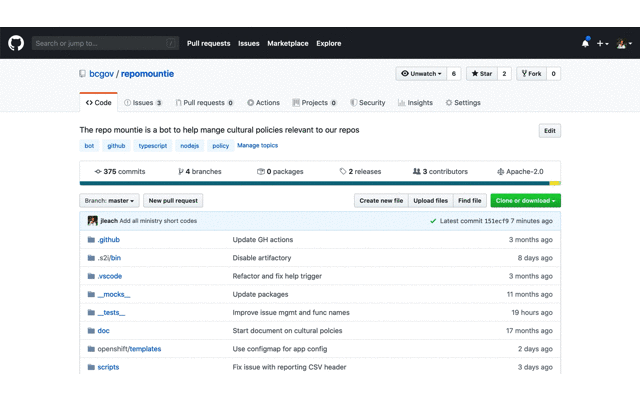A set of shell scripts, makefiles and a helm chart to help the Climate Action Secretariat team deploy applications to the OpenShift cluster.
The Makefile in this repository has two main commands used to, respectively, grant access to the appropriate OpenShift namespaces, and to add common configuration items in said namespaces
To be run anytime the CAS team members change, or new namespaces are added
Loads the list of namespaces from the .env file (see .env-example, the actual .env file is stored in the teams password manager), reads the list of users present in the appropriate GitHub teams (see teams descriptions on GitHub), and create a RoleBinding object for each user/namespace pair.
This script first deletes the previously created RoleBindings (identified by a label) and recreates them based on the GitHub teams membership, to ensure that previous team members access is revoked.
Because it temporarily revokes access for all team members, this needs to be run manually by one of the current members listed as technical lead on the project registry, as they are also granted access via a RoleBinding created by the Platform Services team.
Deploys the [cas-provision helm chart] to every namespace used by the team. This relies on a hidden .values.yaml file (stored in the team's password manager) and creates various objects such as:
deployer,linterandjob-runnerroles following the least privilege principle. Those roles are only allowed to manage objects used in the CAS team's projects, and would need to be updated if new OpenShift object types were to be used (e.g. see PR #53, whenhorizontalpodautoscalerswere first used).- secrets listing the namespace names of the various applications (which are randomly generated when provisions), providing easier referencing for developers, .i.e. an application can look at the
cas-namespacessecret to refer to the namespace of other applications. - a DockerHub registry credential
- a
SysdigTeamobject, which is a custom resource created by platform services to grant access to the Sysdig monitoring platform. - various secrets containing credentials used by our applications
- Utilizing
gcp(the Google Cloud Platform CLI), creates buckets for TF state for every namespace used by the team. Relies on a being authorized with a service account (credentials stored in the team's password manager) with storage permissions on the project.- Note:
gcpwill give errors when a bucket is created already under the service accounts control. The script ignores these errors, as they don't need to block further buckets from being created or the rest of the make target executing.
- Note:
Deploys the [crunchy-monitoring helm chart] to the namespace defined in the values file. This relies on a hidden .crunchy-values.yaml file (stored in the team's password manager).
- requires defining the CIIP_NAMESPACE_PREFIX variable
Lints the [crunchy-monitoring helm chart]
- requires defining the CIIP_NAMESPACE_PREFIX variable
Prior to using Helm to deploy applications to the OpenShift cluster, the CAS team used a set of common make commands (e.g. configure, build, install) that abstracted the oc command line tool. These came with various utility functions located in the *.mk files, which are still in use in some projects but are considered deprecated.
- Import the Helm Chart into your project's main chart as a dependency.
- Update your
values.yaml(and any environmental versions of values) with those required by the terraform-bucket-provision chart:2a. If the project shares a namespace with another one (as is the case with
cas-metabasesharingcas-ggircs's namespace), use theworkspacevalue with anything other than default to create a seperate Terraform workspace in the state to avoid overwriting.
terraform-bucket-provision:
terraform:
namespace_apps: '["example-project-backups", "example-project-uploads"]'
workspace: example # This value is OPTIONAL, only set if requiredThis repo contains a Helm chart that contains a job that will import and run Terraform files. It deploys at the pre-install, pre-upgrade hooks. This chart references secrets and config that is deployed to a namespace when a project is provisioned by cas-pipeline (credentials, project_id, kubeconfig, terraform backendconfig).
terraform-apply.yaml: This file defines the Job that deploys a container to run Terraform. Secrets (deployed by make provision) contain the credentials and .tfbackend Terraform uses to access the GCP buckets where it stores state. The terraform-modules.yaml ConfigMap is what pulls in the Terraform scripts that will be run.
In tandem with the Helm chart is a Terraform module that creates GCP storage buckets, service accounts to access those buckets (admins and viewers) and injects those credentials into OpenShift for usage. These modules are pulled in via a configMap which pulls all files from this charts /terraform directory. These are bundled with the chart as the way we use Terraform is currently identical in our CAS projects.


